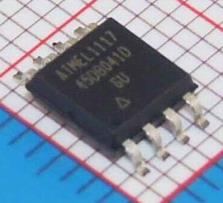产品规格:
产品数量:
包装说明:
关 键 词:服务器硬盘存储
行 业:电子 电子产品设计
发布时间:2021-04-16
Ready/Busy status is indicated using bit 7 of the status register. If bit 7 is a 1, then the device is
not busy and is ready to accept the next command. If bit 7 is a 0, then the device is in a busy
state. The user can continuously poll bit 7 of the status register by stopping SCK at a low level
once bit 7 has been output. The status of bit 7 will continue to be output on the SO pin, and once
the device is no longer busy, the state of SO will change from 0 to 1. There are eight operations
which can cause the device to be in a busy state: Main Memory Page to Buffer Transfer, Main
Memory Page to Buffer Compare, Buffer to Main Memory Page Program with Built-in Erase,
Buffer to Main Memory Page Program without Built-in Erase, Page Erase, Block Erase, Main
Memory Page Program, and Auto Page Rewrite.
Buffer to Main Memory Page Program with Built-in Erase
Data written into either buffer 1 or buffer 2 can be programmed into the main memory. To start
the operation, an 8-bit opcode, 83H for buffer 1 or 86H for buffer 2, must be followed by the four
reserved bits, 11 address bits (PA10 - PA0) that specify the page in the main memory to be writ�ten, and nine additional don’t care bits. When a low-to-high transition occurs on the CS pin, the
part will first erase the selected page in main memory to all 1s and then program the data stored
in the buffer into the specified page in the main memory.
place in a maximum time of tP. During this time, the status register will indicate that the part is
Main Memory Page Program Through Buffer
This operation is a combination of the Buffer Write and Buffer to Main Memory Page Program
with Built-in Erase operations. Data is first shifted into buffer 1 or buffer 2 from the SI pin and
then programmed into a specified page in the main memory. To initiate the operation, an 8-bit
opcode, 82H for buffer 1 or 85H for buffer 2, must be followed by the four reserved bits and 20
address bits. The 11 most significant address bits (PA10 - PA0) select the page in the main
utilized at a later time. To perform a Page Erase, an opcode of 81H must be loaded
into the device, followed by four reserved bits, 11 address bits (PA10 - PA0), and nine don’t care
bits. The 11 address bits are used to specify which page of the memory array is to be erased.
When a low-to-high transition occurs on the CS pin, the part will erase the selected page to 1s.
Successive page programming operations without doing a page erase are not recommended. In
other words, changing bytes within a page from a “1” to a “0” during multiple page programming
operations without erasing that page is not recommended.
Additional Commands
Main Memory Page to Buffer Transfer
A page of data can be transferred from the main memory to either buffer 1 or buffer 2. To start
the operation, an 8-bit opcode, 53H for buffer 1 and 55H for buffer 2, must be followed by the
four reserved bits, 11 address bits (PA10 - PA0) which specify the page in main memory that is
to be transferred, and nine don’t care bits. The CS pin must be low while toggling the SCK pin to
load the opcode, the address bits, and the don’t care bits from the SI pin. The transfer of the
page of data from the main memory to the buffer will begin when the CS pin transitions from a
low to a high state. During the transfer of a page of data (tXFR), the status register can be read to
determine whether the transfer has been completed or not.





